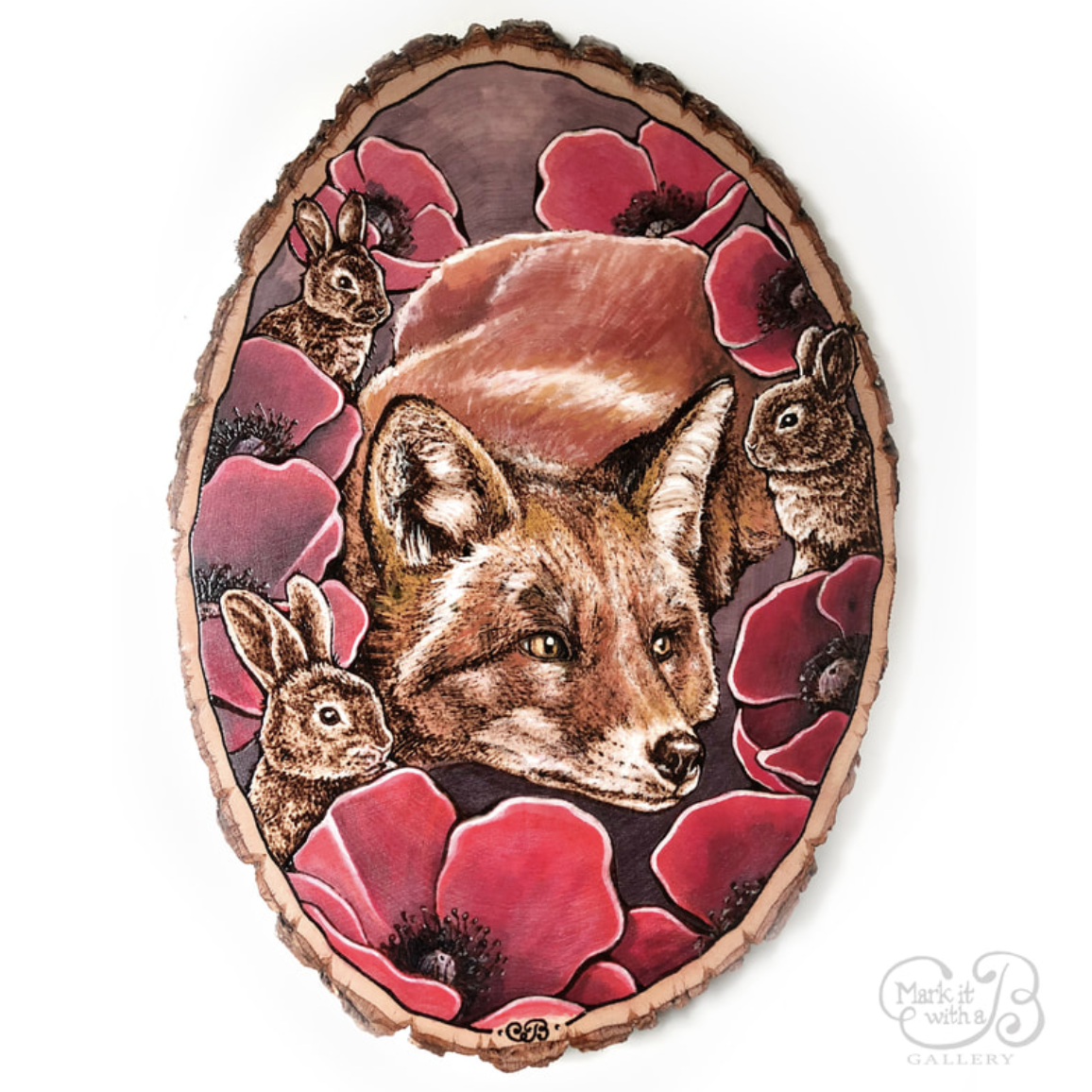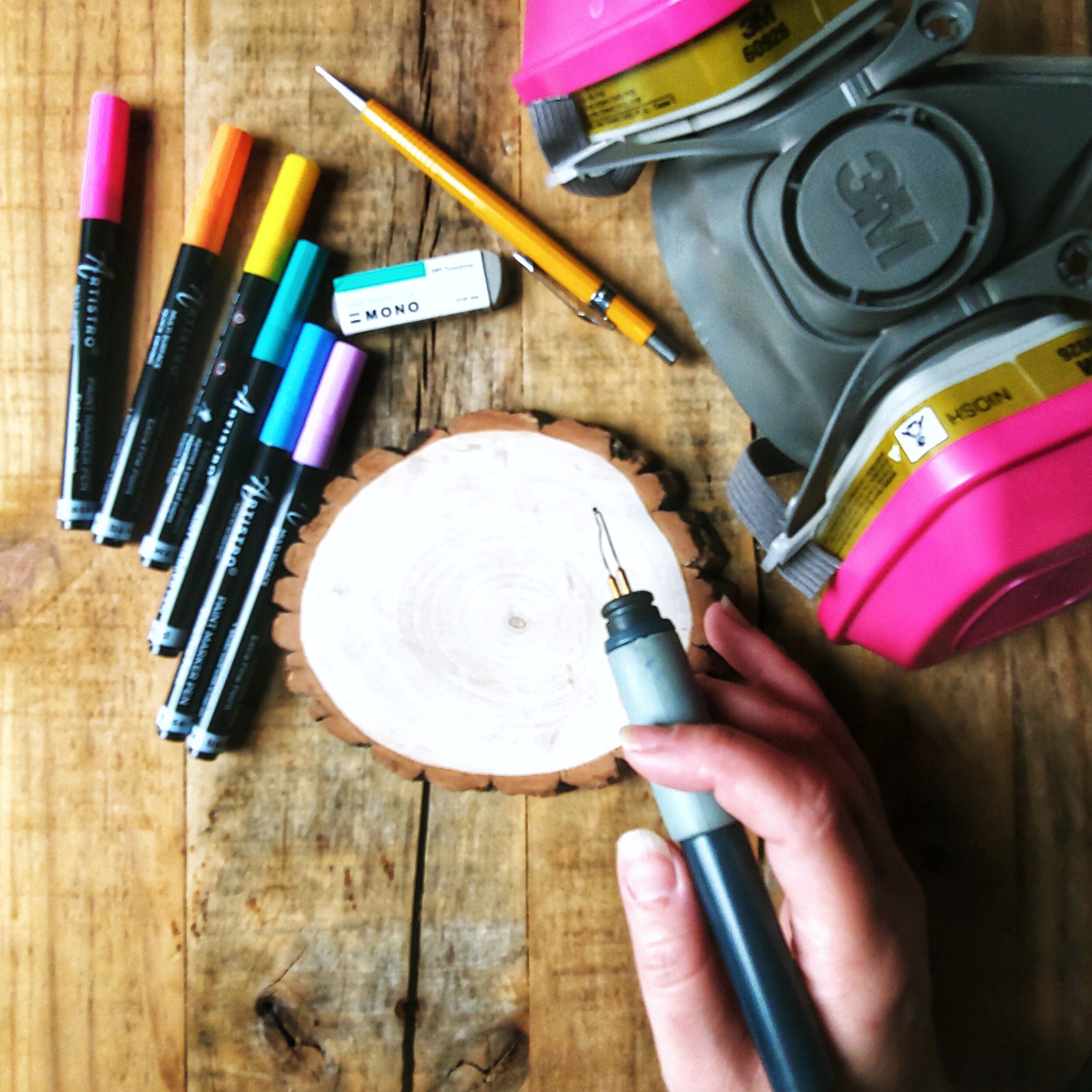Name: Brandy Roels
Burning since: 2016
Location: Michigan, US
What does your shop specialize in/offer?
This is Brandy Roels, owner and artist of Mark it with a B Gallery LLC. I run my small business out of my in-home studio in Michigan, US. I focus on woodburning custom pet and people portraits, as well as niche fan art, fantasy art, and wildlife art. All my woodburning is done completely by hand, and I print prints of my work straight from my studio.
Have you always been an artist?
I started drawing at age three (always animals) and admired pet portrait artists. Art became my passion, and I continued taking every art class offered up through high school and private art lessons outside of school. In 2015, I graduated Summa Cum Laude from the Savannah College of Art and Design (SCAD) with a BFA in Illustration. My main focus was painting realistic portraits.
I officially started my business in 2016 by offering portraiture painting, candle-making, sculpting, card-making and woodburning. It was way too much! I narrowed it down to just woodburning a year later, making fun signs, cooking utensils and cutting boards. However, I missed my background in portraiture and found a way to combine portraits and woodburning.
How did you find your distinct artistic voice?
I stopped making the types of pieces I thought people would buy and started making pieces that truly expressed me. I love creating subject matter of animals, fairies/fantasy and fan art from films/tv. I also wanted to start sharing more of myself in my pieces. Not just making pretty pieces but making emotional pieces - expressing my emotions and evoking emotions for the viewer.
Style:
My art style just kind of happened one day. This one is hard to explain. I remember creating a realistic bunny illustration, and I did not like the way the fur sort of got lost into the color of the wood. So, I added an outline around the exterior form of the bunny, like how tattoo artists draw outlines. Thus, my classic outline began!
Is it scary to be vulnerable with your art? To put real life into it? Is it therapeutic to create? Does it feel different when you are creating those pieces versus a dog portrait?
I know I’m not the first person to say this, but being vulnerable is hard. It almost feels easier to just keep things inside to yourself. I just got tired of doing that! The only person I had been completely vulnerable with was my husband, but I still felt alone and like I was bothering him by re-bringing things up I had not moved passed. Of course, he was not bothered and is a very understanding, kind man.
I started sketching what I was feeling and called it “nonjudgmental sketching” (just sketch, don't think and don’t judge myself on what I draw). One day, I created a full, finished woodburning and painting piece ("Mother" - my first pregnancy piece based on one of my miscarriages). From there, I decided I would share it on social media and tell my story. After doing that, I found I was NOT alone, people were NOT judging me based on what happened, and people actually thought my piece was beautiful and powerful. A huge part of me healed that day.
Now I make personal pieces to express my deep emotions or unsolved past trauma. I found it does help heal me and certainly is therapeutic. My creative process is more mellow and slow, versus my fast hatch-marking fur technique I do for pet portraits. I still have the same focus for pet portraits, but because my attachment is different my process is faster for pet portraits.
What helps you get into a creative headspace? Certain music? A food or drink? A candle? Is there a routine to it?
Honestly, nothing specific! I usually just automatically start feeling the need to be creating/working or doing SOMETHING with my hands. I set my own schedule but like to start working at around 9 AM every morning and go until my husband gets home at 5 PM. Even after he comes home (and we are trying to relax), that need to keep doing something with my hands continues. I have tried "making" myself work on a hobby in the evening instead of continuing regular work - to keep me sane.
What percentage of time do you spend on actual wood burning versus business running?
I spend most of my time woodburning/creating for sure. When it comes to business upkeep (like making an email newsletter or updating my website or financial spreadsheet), I dedicate a specific day (or couple of days) in order to give it my full attention and just get it done. It’s definitely not the most fun part, but it is needed and should receive my full attention.
What things have you implemented that makes your whole business run smoother? What tips or pieces of advice can you give someone who would like to make their business run a little more smoothly?
It was one of those periods of time where I realized I’m trying way too hard. I decided there needs to just be one way for doing each aspect of my business. For example, I kept changing my creative process leading up to creating a custom piece (too much back and forth with the customer) or changing up my shipping/packaging. Now everything I do just has one way of getting it done. For advice, ask yourself if you’re happy with the way you do everything. What are you not enjoying? What can be made simpler/combined AND keep you happy?
One main thing that helped me in “being more official” was keeping track of ALL the money I made and spent. My husband created a spreadsheet for me (he’s a techy engineer), where I can input everything into categories. These include: Online Income, Commission Income, Fees (like processing fees taken from my online shop), Donations (I make), Office/Studio Purchases, Advertising Purchases, Shipping Purchases, etc. It’s exactly like balancing a checkbook! Mine is set to monthly, and I upload each purchase or sale immediately. When tax time comes, I have everything sorted and my sales tax I owe already calculated to pay my state.
What goals do you have for Mark It with a B Gallery? Any art goals?
My main goal is to open a gallery and store space where I could set up my studio to create all my work, sell my work/other woodburning artists' work/responsibly sourced pet and baby goods, and have a classroom to teach art classes/private art lessons. I already have the business plan and cost sheet in place!
Any lessons learned the hard way that you want to spare someone the time?
1. Stop saying yes to everyone! Make sure you can actually create the piece OR that you really want to make the piece. I actually stopped accepting truly custom pieces, meaning things I don’t normally create. I understand needing the money, but I honestly value my happiness more. I usually ended up undervaluing the cost of those custom pieces too!
2. Woodburning art fades NO MATTER the sealant as soon as it’s touched by the sun. This is why I started making prints!
3. Clean the tips!! I’ve damaged quite a few tips from never cleaning the carbon debris or using a sanding block to try to wipe it off. It just sands away your tip shape. I use a leather strop with polishing compounds.
Deserted Island, with power question. You can choose ONE
Burner: Colwood Detailer
Nib: BALL POINT
Type of wood: Basswood
Non-essential tool: Quinn (husband)
Why the ball-point? Do you think you will ever use another nib?
I started out with Walnut Hollow’s basic green woodburning unit, and I would only use the Cone Point and Flow Point. It really was not until I upgraded to Walnut Hollow’s Creative Wood Burner with wire tips that tried the ball point tip. Then I was hooked! I’m able to do everything with it! I actually (truly) don’t know how to use ANY of the other tips for woodburning. Seriously! I might break out someday and actually try other tips for fun. As for now, I only own the ball point tip for my Colwood Detailer machine.
How do you add color to your pieces and do you have a favorite?
I love to use various types of paint! Since I was a portrait painter, I just enjoy the feeling of spreading paint around - especially on smooth wood. I find I end up blending my paint strokes in with my woodburning marks, such as adding short brushstrokes of color in with an animal's fur. I like everything I use to be water soluble, so even the oil paint I get is safe to use with water. My favorite paints I use are:
1. Winsor and Newton Watercolor Paint Tubes
2. Golden Paint Acrylic Paint
3. Holbein Acryla Gouache
4. Holbein Duo Aqua Oil WATER SOLUBLE Oil Paint
5. Winsor and Newton Artisan WATER MIXABLE Oil Paint
What are some of your favorite tools in your toolbox?
For woodburning, I honestly do not use much else other than my woodburner. I like to draw my designs directly on the wood using a graphite pencil and kneaded eraser. While I am woodburning, I will occasionally use a box cutter blade to erase any unwanted woodburning lines or areas that I burned too dark. It can also add some texture! Pretty boring, but that's it!
How do you make prints?
I print them myself at home. I have a Canon Pixma Pro 100. My process is I photograph my pieces, edit the picture and format the piece to fit on 5x7 and 8x10 sizes, and then just print. I like to use matte finish paper so there are no glares on my work. I tried using ink that was compatible with my printer, but I gave in and now use the expensive Canon brand ink. It's just better in the long run, trust me! I also use Canon brand paper (Photo Paper Pro Premium Matte).
If interested, you can order prints from printing companies online instead of buying your own printer. Kinkos definitely has great paper options and is not so bad price-wise. I have also heard great things from this site: finerworks.com
What do you use to finish your pieces?
Like I said earlier, I love using products that are water-based. The sealant I use is Rust-Oleum Varathane WATER-BASED Spar Urethane Exterior with UV Protection (woodburning will still fade if placed directly in sunlight). It's available in a paint-on can or spray can (I prefer the spray!).
Dream collaboration? Business or person?
I know that I would love to collaborate with local and national pet rescues or adoptions, using my pet portraits as a way to help raise money for their business/for all those cute pets out there needing a home. If I do open my own gallery/store someday, I plan to have a pet adoption day event in my store often where people can adopt and get one of my pet portraits (where the proceeds would go to the rescue business).
What are you working on now?
Growing a baby! I am currently pregnant with a baby girl, and this time I am seriously taking it easy after my previous miscarriages. I still have custom pet portrait orders I am creating, but I am keeping my environment as mellow as possible. My online store is currently closed, and I plan to open it again around the holiday time with limited edition items. Stay tuned!
Watch the recorded live video:





















